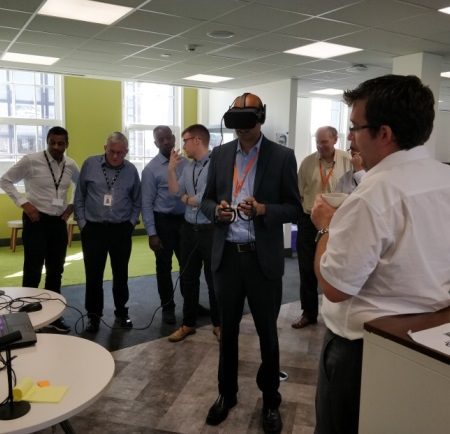‘Through the eyes of the visually impaired’
It was raised that the visually impaired may have difficulty using certain parts of a structure, i.e. it may be difficult to see the edges of the platform.
In order to aid this, Technology Improvement Manager at Osborne, Dominic Lowry mapped a Revit model of Ewell West Station AfA footbridge. Using the computer programme Unity the Revit model was put into a to-scale map of Ewell. Then using a Virtual Reality (VR) headset and controllers people were able to come in for a drop-in session and use the VR headset to see how people who are visually impaired see the world.
The visual impairments included macular degeneration, glaucoma, cataracts and colour blindness (Protanopia, Deuteranopes and Tritanopes). This was based on the Cambridge Simulation Glasses Experiment which showed people with normal vision how general loss of vision can make general day to day product use more difficult.
The drop-in session was created with the aim of opening people’s eyes to what it’s like to live with a visual disability. In turn, this would help the designs we use to be safer for members of the general public and for site team members. One good way that this will be included is some kind of contrasting skirting boards or walls along edges so that people with cataracts can see walkways where they would otherwise merge into one. In addition to the visually impaired benefits, the benefits for site work are also substantial. If models are to-scale and accurate they can be used in the processes performed before attending site so that team members will be able to get a better understanding of the site as if they were walking through it themselves.
The session was held in the Waterloo Offices, allowed a number of people from One Team Wessex to really understand how people with certain visual impairments see the world and relate it to people that they know who may suffer from one of these problems.
Using VR sessions with design models will also enable creation of a design that will enable people with visual impairment to be able to use the construction as easily as anyone else. Colour schemes will also be selected in order to include people with colour blindness (i.e. vibrant yellow handrails) as this will help contribute to the overall safety of people using the end product.
VR sessions won’t just provide benefits in terms of visual impairment. Individuals will be able use this technology to view a site before they visit it, learn where things like access points are and learn how to safely make their way around the construction site in a much more practical and memorable way than previous methods.

